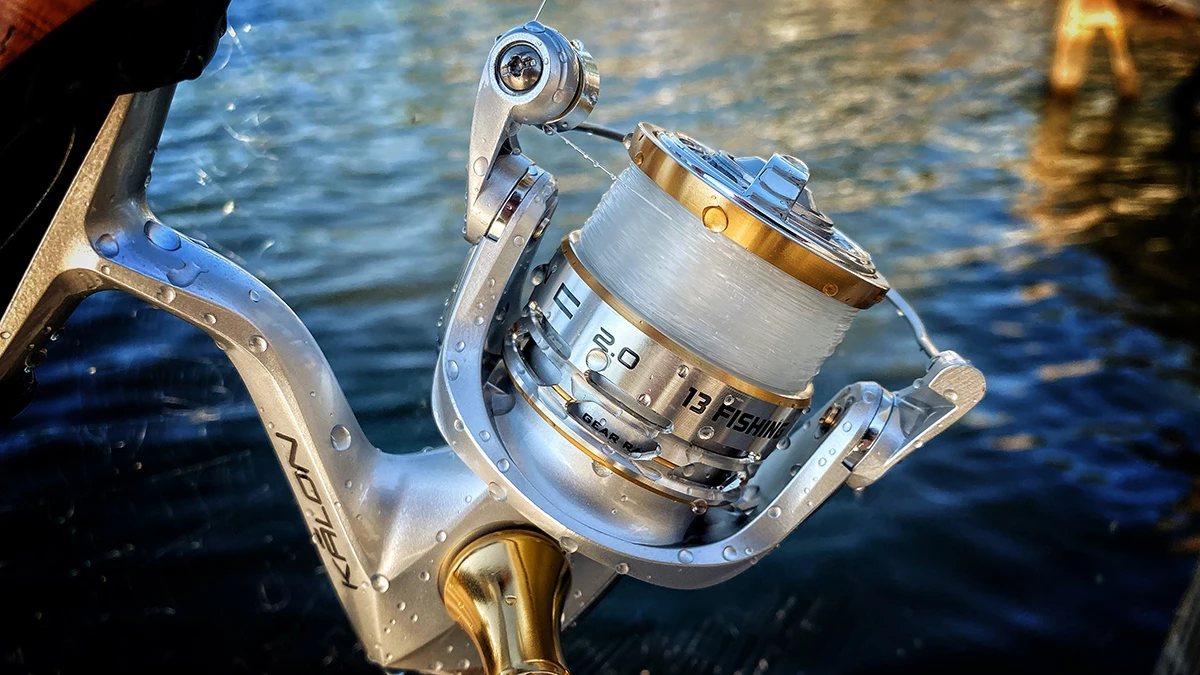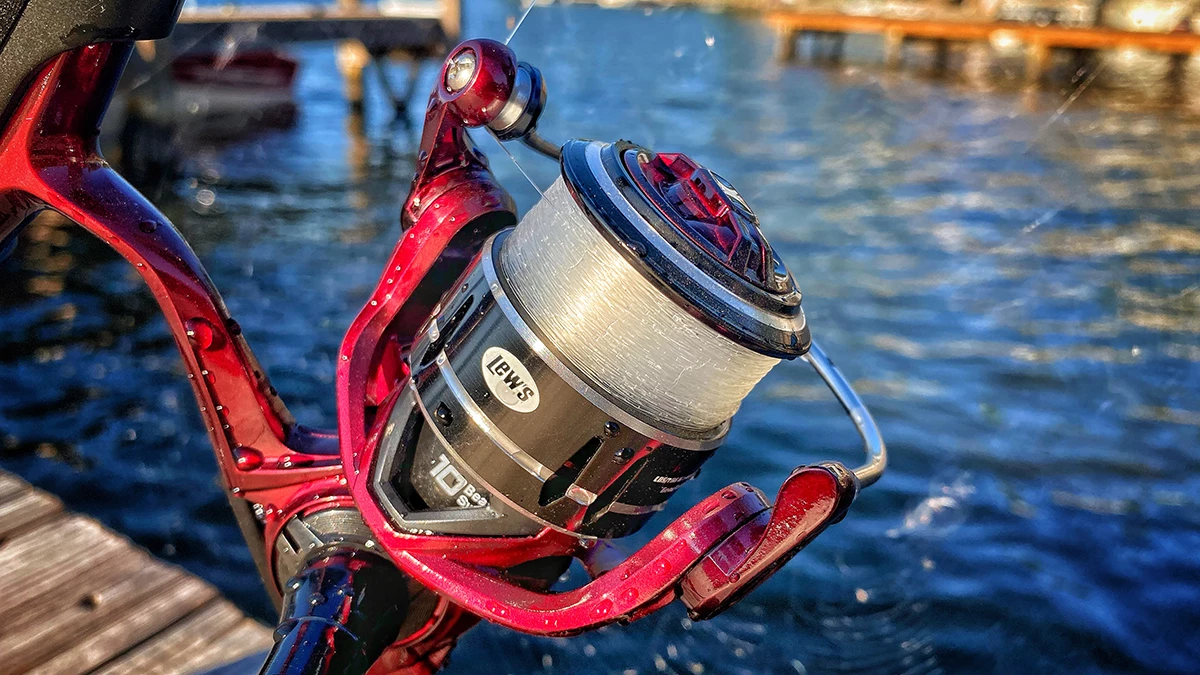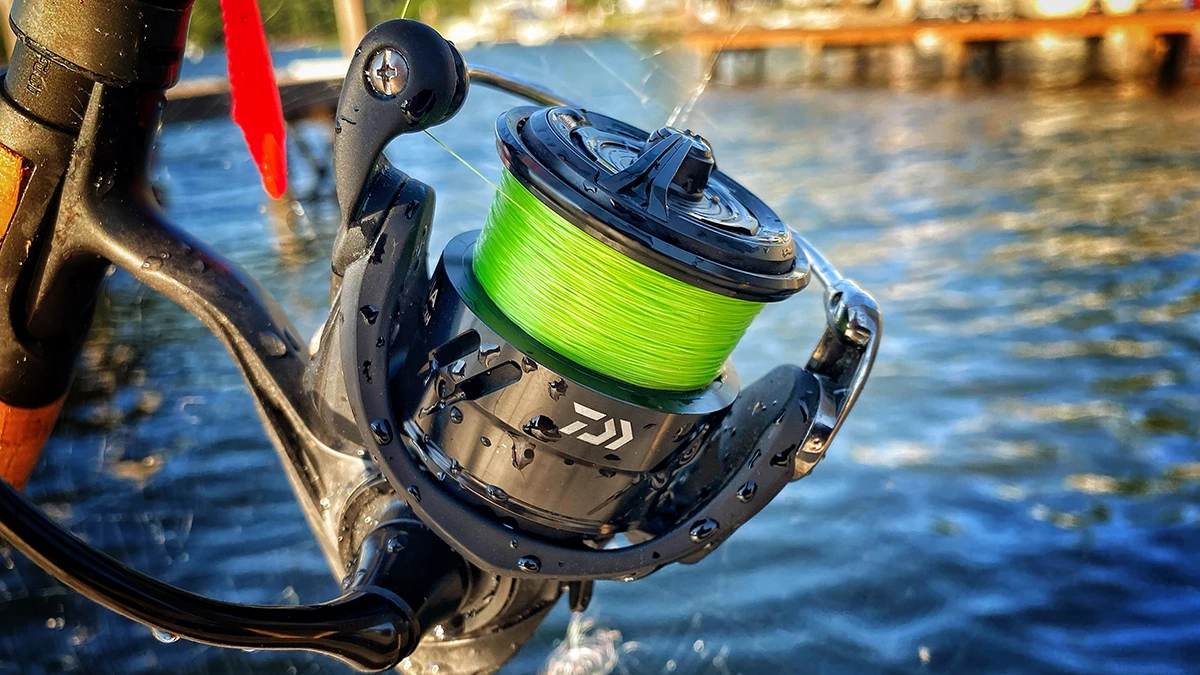Warning: Undefined variable $k in /home/nginx/domains/wired2fishcom.bigscoots-staging.com/public/wp-content/themes/understrap-child-0.6.0/functions.php on line 984
Warning: Undefined variable $k in /home/nginx/domains/wired2fishcom.bigscoots-staging.com/public/wp-content/themes/understrap-child-0.6.0/functions.php on line 987
Choosing the right fishing line for bass fishing spinning reels can pretty pretty overwhelming at times. I remember when I was a college angler, I was flat-out broke and found a bunch of complicated advice on the internet. I was no finesse-fishing guru and for every three folks who would swear by one type of line, there would be another three saying the exact opposite. I think that messes with all of us a lot in bass fishing. Information overload is a real thing, so I wanted to put this piece together to help you make a comfortable decision the next time you’re putting line on a new spinning reel.
I’m going to break it down into three primary categories—fluorocarbon, monofilament and braided line. Each have a time and a place and to be totally honest, you can’t really go wrong with either of them. Depending on the way you like to fish, each of these lines can be advantageous to you.

Fluorocarbon fishing line
Fluorocarbon fishing line is a great option for spinning reels but certain precautions need to be taken, in my personal opinion. It’s a bit more expensive and it can also have issues with line memory at times. In other words, if you leave it on your spinning reel for a few weeks, it can turn into a slinky-type shape and cause major tangles when you cast it. But thankfully, line technology has drastically improved in recent years and there are also line conditioners you can use that will virtually eliminate line management issues.
I’ll start by saying that often times, you get what you pay for when it comes to using fluorocarbon line on spinning reels. There are some reasonably priced fluoros out there, such as Vicious, that behave really nicely on spinning reels. But I wouldn’t necessarily suggest digging in the bargain bin for the cheapest fluorocarbon you can find. I appreciate and totally relate with folks who like to fish on a budget, but this is one purchase I don’t really skimp on.
So why in the world would you throw fluorocarbon on a spinning reel? The answer is fairly straightforward; invisibility and sensitivity. This type of fishing line has less stretch that monofilament which, of course, leads to much more sensitivity while you’re retrieving your lure. So if you’re dragging a shaky head through a brush pile, you’re able to feel those light bites much easier. It’s also very transparent in the water, which can be a major help when you’re fishing in clear water. The bass don’t see it as well and are more apt to bite your lure because of the more natural-looking presentation. Also, read our guide on Best Fluorocarbon Fishing Lines.
Use a line conditioner
Finally, I’ll also recommend using some type of line conditioner if you’re using straight fluorocarbon on your spinning reels. The night before I go fishing, I’ll go into my shop and spray the fluorocarbon as it sits on my spinning reels. It’s fairly affordable and it can make a noticeable difference in regards to line memory. This will help both your casting distance and accuracy. There are all kinds of varieties out on the market and I’ve tried many. I would suggest, however, to avoid using aerosal conditioners because they can actually dry out your fluorocarbon and cause line failure after a few applications.
I can recommend Kevin VanDam’s Line & Lure Conditioner (full review), which is available at the following retailers:

Monofilament fishing line
Let’s go old-school for a moment, shall we? If you’ve read a few of my articles, you’re very well aware that I have a strong appreciation and reverance for the old-school anglers out there. I try not to turn bass fishing into rocket science which is why I’m a big proponent of using good, old-fashioned monofilament fishing line on spinning reels. I don’t care if it’s a $50 reel or a $250 reel; I’m not afraid to slap some affordable mono on it and start skipping docks and laydowns.
Monofilament is going to be your most afforable option when it comes to spooling up your spinning reel. Not many folks do this anymore, however, because monofilament line has a lot of stretch to it. Contrary to fluorocarbon, this results in slower bite detection and a decrease in sensitivity. So if you’re dragging something along the bottom using mono, it might take you a split-second longer to feel a bass bite your bait which, as I’m sure you know, can make you totally whiff on the hookset.
Where I find monofilament to be most useful is when I’m using shallow-water techniques where I can see my bait as I work it back to the boat or the bank. So if I’m using a weightless soft jerkbait, a weightless trick worm or a wacky rig, I’m all for using monofilament. Because when I’m fishing in this manner, I don’t always need to feel the bite; I can see it, so the added stretch of monofilament isn’t that big of a deal. It also has much less memory than fluorocarbon so it behaves very well on the reel. You won’t have to deal with many line tangles or line twist, even in breezy conditions. Also, read our guide on Best Monofilament Fishing Lines.
Don’t get all spun up if you don’t want to spend a bunch of money on other, higher-end types of lines. Get you a regular ol’ spool of 8-pound monofilament and slap it on your favorite spinning reel because as long as you can see your bait throughout the retrieve, you’ll be good to go and catch a bunch of bass.

Braided fishing line
Now we’re going to touch on the setup that a lot of hardcore finesse bass anglers use. Braided fishing line is widely known for its no-stretch qualities which means you can feel virtually every single thing your bait is doing throughout the retrieve. If a bass bites it or a bluegill sneezes on it, that sensation will immediately transmit to your rod blank which will allow you to detect even the faintest of bites. The hold up for many anglers, however, is the potential hassle that comes along with this setup.
When you spool a spinning reel with braided line, it’s imperative to use a 4- to 6-foot fluorocarbon leader which, depending on your experience level, can be both intimidating and a pain in the rear end. Leader knots aren’t easy for everyone to tie and if you don’t tie ‘em correctly, it adds a major potential failure point in your finesse-fishing system. There’s not a much worse feeling than getting a good bite and having your leader knot break when you set the hook.
So with that being said, it’s important to practice your knot-tying skills if you want to spool braided line on your spinning reel. But if you take the time to find a favorite leader knot and master it, you’ll quickly become a believer in braided line. You’ll feel more an the added fluorocarbon leader will be virtually invisible to the fish, which will result in a bunch of bites. Essentially, if a fish breathes on your bait while you’re fishing this setup, you’re going to feel it and be able to set the hook quickly and efficiently. Also, read our guide on Best Braided Fishing Lines.
As the weather cools down, fishing can get tough and it will get tough; you’re going to have to pull out the spinning gear eventually. But again, I wanted to put this piece together to remind you that it’s not necessary to overcomplicate this stuff. Depending on your preferred method of fishing, there are several different lines out there at different price points that will cover your needs and provide you with a quality fishing experience.












